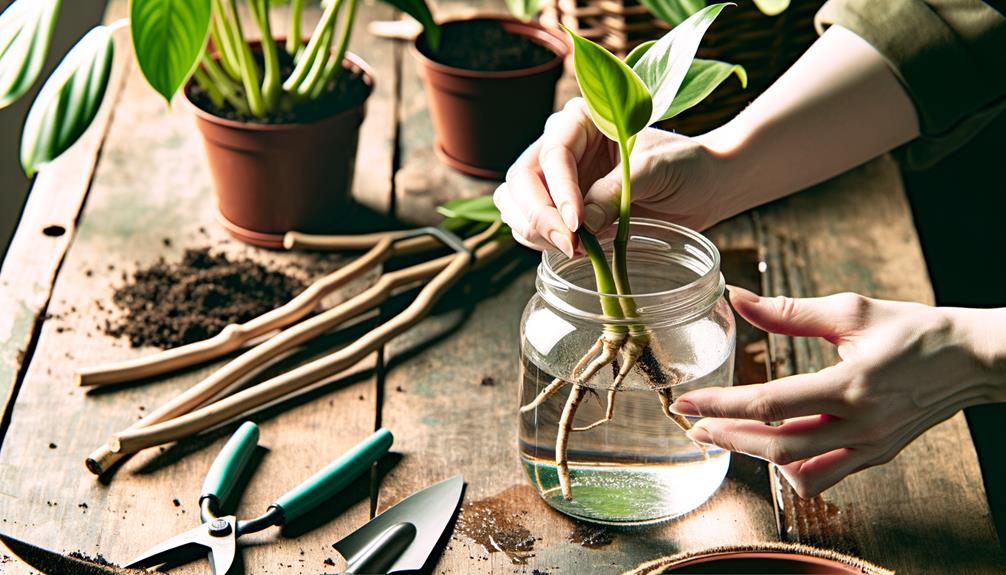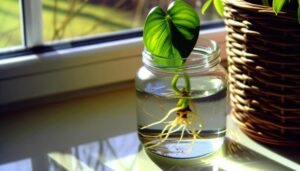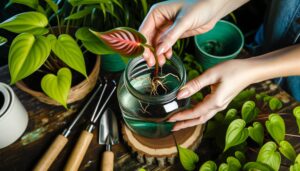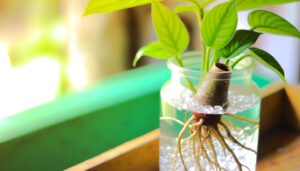Philodendron Brandi Propagation
Propagating Philodendron Brandi necessitates precision and appropriate tools such as sterilized pruning shears, rooting hormone, and a suitable growing medium. Start by selecting a healthy stem with unblemished leaves and identifying a viable node for cutting with sterilized shears.
For rooting, submerge the cutting in water within a clear container or place it in a well-draining potting mix. Guarantee the cutting receives bright, indirect sunlight and maintain humidity levels at 60-70%.
Regularly monitor for root development and new leaf growth. Proper care includes watering when the soil’s top inch is dry and addressing issues like root rot or nutrient deficiencies.
Continue to explore for further insights.

Key Takeaways
- Use sterilized pruning shears to take a healthy stem cutting with at least one node.
- Submerge the cut end in water or plant in a well-draining potting mix.
- Place the cutting in bright, indirect light and maintain humidity at 60-70%.
- Change water every few days or keep the soil moist, not wet, to prevent root rot.
- Monitor for white, firm roots and new leaf growth before transplanting to a larger pot.
Gathering Materials
To successfully propagate Philodendron Brandi, it is important to methodically gather all necessary materials, including sterilized pruning shears, a rooting hormone, a suitable growing medium, and clean containers with proper drainage.
Sterilized pruning shears reduce the risk of introducing pathogens that could compromise plant health. A rooting hormone, typically containing auxins, facilitates root development by stimulating cellular growth at the cut site. The growing medium, ideally a blend of peat moss and perlite, guarantees optimal moisture retention and aeration, essential for root establishment. Containers should have adequate drainage to prevent waterlogging, which can lead to root rot.
Each material plays an integral role in creating a conducive environment for successful Philodendron Brandi propagation, ensuring healthy and vigorous growth.
Selecting the Cutting
When selecting a cutting for propagating Philodendron Brandi, it is essential to choose a healthy stem with vibrant, unblemished leaves, ensuring the plant’s overall vigor.
Accurate identification of nodes, where root development initiates, is critical for successful propagation.
Utilizing sterilized, sharp cutting tools will prevent disease transmission and promote clean, precise cuts, optimizing the chances of successful root growth.
Healthy Stem Selection
Selecting a healthy stem for propagation requires identifying a segment with robust growth, ideally featuring at least two to three nodes and vibrant, green foliage. This guarantees the cutting has sufficient energy reserves and growth potential to establish new roots and thrive post-propagation.
When selecting the cutting, consider the following criteria:
- Node Presence: Confirm the stem has multiple nodes; these are critical for root development.
- Foliage Health: Look for leaves that are free from discoloration, pests, and disease.
- Stem Integrity: Choose a stem that is firm and free from any signs of rot or mechanical damage.
Node Identification Tips
Identifying nodes accurately is essential for successful propagation. These small bumps along the stem are the primary sites from which new roots will emerge. Nodes are typically located just below the petiole, where the leaf joins the stem, and exhibit a slight swelling.
To ensure best root development, select a node that displays robust characteristics: a pronounced bump, healthy coloration, and no signs of rot or disease. It is important to avoid internodal segments, as they lack the necessary cellular structures for root initiation.
Carefully examine the stem, making sure the chosen node is fully mature and not in a juvenile stage, as immature nodes may not possess the required vigor for successful propagation.
Proper Cutting Tools
To guarantee a clean and precise cut for propagation, selecting the appropriate cutting tools is crucial. The selection of tools can greatly impact the health and success of your Philodendron Brandi cuttings. Key considerations include sharpness, sterility, and ease of use.
- Pruning Shears: High-quality, sharp pruning shears are essential for making clean cuts without crushing the plant tissue.
- Scalpels or Razor Blades: These are ideal for making precise incisions, especially in delicate areas. Make certain they are sterilized before use.
- Alcohol Wipes: Regularly sterilize your tools between cuts with alcohol wipes to prevent the spread of disease and infection.
Preparing the Cutting
To maximize successful propagation of Philodendron Brandi, begin by selecting healthy stems that exhibit vigorous growth and are free from disease.
Next, sterilize your cutting tools with isopropyl alcohol to prevent the transmission of pathogens.
Selecting Healthy Stems
When choosing healthy stems for propagation, it is crucial to pick those that show strong growth, vivid coloration, and are clear of any signs of disease or pest infestation. An analytical approach guarantees the success of the propagation process.
- Growth Nodes: Select stems with at least one visible node, as these are crucial for root development.
- Leaf Quality: Make sure the leaves are green and healthy, free of yellowing or browning, which could indicate underlying issues.
- Stem Integrity: Choose stems that are solid and resilient, avoiding any that seem wilted or damaged.
Sterilizing Cutting Tools
Ensuring cutting tools are thoroughly sterilized is paramount to prevent the introduction of pathogens during the propagation process. Utilize isopropyl alcohol (70% concentration) or a solution of one part bleach to nine parts water for effective sterilization.
Immerse the blades for at least 30 seconds, ensuring full contact with the disinfectant. After soaking, rinse the tools with distilled water to remove any residual chemicals that may harm the plant tissues.
Dry the tools completely using a sterile cloth or air drying in a clean environment to avoid recontamination. This meticulous preparation reduces the risk of fungal or bacterial infections, which can compromise both the parent plant and the new cuttings, thereby optimizing propagation success.
Optimal Cutting Location
Selecting the best cutting location on the Philodendron Brandi involves identifying a healthy stem segment containing at least one node and a few leaves, as these structures are essential for successful rooting and subsequent growth. To achieve the best propagation results, follow these steps:
- Identify a Healthy Stem Segment: Choose a vigorous stem, free from disease or pest damage, that exhibits robust growth.
- Locate the Node: The node is a critical point where roots will emerge. Ensure the segment includes at least one node.
- Ensure Sufficient Leaf Coverage: Select a segment with two to three leaves to provide enough photosynthetic capability during the rooting phase.
Rooting in Water
Rooting Philodendron Brandi cuttings in water involves the meticulous process of submerging the cut end in a sterile environment to promote root development.
Begin by selecting a clear container, preferably glass, to monitor root growth. Fill the container with distilled water to eliminate contaminants. Submerge the cutting, ensuring at least one node is underwater, as roots will emerge from this point.
Place the container in indirect sunlight to prevent algal growth, which can impede oxygen exchange. Change the water every few days to maintain oxygen levels and prevent bacterial buildup.
Within 2-4 weeks, root structures should begin to form. Observe for healthy, white roots before transplanting, as they indicate successful root initiation and propagation readiness.
Rooting in Soil
Initiating the propagation of Philodendron Brandi through soil necessitates the preparation of a well-draining potting mix to facilitate ideal root aeration and moisture regulation. To achieve this, it is crucial to blend specific components that optimize the growing environment.
- Soil Composition: A blend of equal parts peat moss, perlite, and orchid bark provides the necessary balance of moisture retention and drainage.
- Sterilization: Sterilize the potting mix to eradicate any pathogens or pests that could impede root development or cause disease.
- Container Selection: Choose a container with adequate drainage holes to avoid water accumulation, which can result in root rot.
Implementing these steps guarantees a conducive environment for the young Philodendron Brandi to establish robust roots in soil.
Planting the Cutting
Once the well-draining potting mix and appropriate container have been prepared, the next step involves carefully placing the Philodendron Brandi cutting into the soil to promote ideal root development.
Begin by creating a small hole in the center of the potting mix, approximately one to two inches deep. Gently insert the cutting into this hole, making sure that at least one node is buried beneath the soil surface, as this will be the primary site for root formation.
Lightly tamp the soil around the cutting to provide stability while avoiding excessive compression, which could impede root growth. Guarantee the cutting remains upright and that the surrounding soil maintains adequate aeration and moisture retention, essential for optimal root establishment.
Providing Proper Care
Ensuring the Philodendron Brandi cutting receives proper care involves meticulously controlling factors such as light exposure, humidity levels, and watering frequency to foster robust root and shoot development.
Key considerations include:
- Light Exposure: Place the cutting in bright, indirect light. Direct sunlight can scorch the leaves, while low light can impede growth.
- Humidity Levels: Maintain a humidity level of 60-70%. Utilizing a humidity tray or a room humidifier can help achieve ideal conditions.
- Watering Frequency: Water the cutting when the top inch of the soil feels dry. Overwatering can lead to root rot, whereas underwatering can stress the plant.
These measures are critical for ensuring the successful propagation and health of Philodendron Brandi.
Monitoring Growth
Closely monitoring the development of new roots and shoots is important for evaluating the progress and health of the Philodendron Brandi cutting. Regular inspections should be scheduled to track the emergence of roots, leaf growth, and overall plant health. Documenting observations in a systematic manner guarantees that any deviations from expected growth patterns are promptly identified.
| Parameter | Observation Frequency | Notes |
|---|---|---|
| Root Emergence | Weekly | Look for white, firm roots |
| Shoot Development | Bi-weekly | Assess for new leaf formation |
| Leaf Color | Bi-weekly | Verify leaves are vibrant and green |
| Stem Firmness | Monthly | Check for signs of rot or decay |
| Overall Vigour | Monthly | Evaluate plant robustness and resilience |
Such meticulous monitoring is important for timely interventions and ensuring optimum growth conditions are maintained.
Troubleshooting Common Issues
Identifying and addressing common issues such as root rot, pest infestations, and nutrient deficiencies are critical for maintaining the health and growth of Philodendron Brandi cuttings.
Root rot is typically caused by overwatering and poor drainage. To mitigate this, make sure the soil is well-draining and only water when the top inch of soil is dry.
Pest infestations, particularly from spider mites or aphids, can be controlled with insecticidal soap or neem oil.
Nutrient deficiencies often manifest as yellowing leaves or stunted growth. Address these by:
- Adjusting the soil pH to secure nutrient availability.
- Supplementing with balanced fertilizers to provide essential nutrients.
- Ensuring proper light exposure to facilitate photosynthesis and nutrient uptake.
Conclusion
To sum up, the propagation of Philodendron brandi, when done with precision and care, can yield successful and healthy new plants. By carefully collecting materials, selecting and preparing cuttings, and choosing suitable rooting methods, ideal growth conditions can be attained.
Providing proper care and monitoring for common issues are crucial. As the saying goes, ‘a stitch in time saves nine,’ highlighting the importance of early intervention to guarantee robust development and reduce potential problems in plant propagation.






